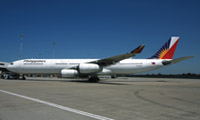News Backgrounder
Far reaching goals for PAL
Philippine Airlines has signalled a major strategic shift in its operations following the lifting of a three-year ban on its European flights.
September 1st 2013
Philippine Airlines (PAL) may have denied reports last month that it was abandoning its domestic market in favour of offshore expansion, but there is little doubt its decision to expand code-share arrangements with low-cost subsidiary, PAL Express, will see a huge increase in domestic passengers flying on no-frills aircraft.Read More »
 |
| Philippine Airlines: new fleet key to international expansion plans |
While PAL spokesperson, Cielo C. Villaluna, insisted the airline “has not pulled out of the domestic sector”, she confirmed all domestic flights, except Cebu, Davao and General Santos, are being “realigned” to PAL Express. PAL international flights operate from the three cities.
The domestic reshuffle followed the long-awaited news in July that the national carrier’s three-year European isolation was over. All Philippine carriers were banned by the European Union (EU) in 2010 because of “serious safety deficiencies” in the country’s aviation regulatory system.
PAL’s blacklisting was lifted because of “improved safety oversight provided by the competent authorities” and the ability of the national carrier to ensure “effective compliance with relevant aviation safety regulations”. The ban remains in place for the country’s other airlines.
PAL president, Ramon Ang, whose San Miguel brewery conglomerate owns 49% of the airline with full management control, said the carrier will be operating daily B777 flights to London, Frankfurt, Paris, Amsterdam and Rome by the end of the year.
More good news appears to be on the horizon. Although PAL flies to the U.S., it has been prevented from using new aircraft or adding destinations into the country since 2007, when the Federal Aviation Administration (FAA) downgraded Philippine aviation standards from Category 1 to Category 2. The Civil Aviation Authority of the Philippines (CAAP) is confident an upgrade will be approved by the end of the year.
The news followed a visit to Manila by FAA inspectors in July. They stayed only a few days before returning to the U.S, suggesting “a positive review of local aviation’’ compliance with international safety standards, according to CAAP deputy director-general, Capt. John Andrews.
The breakthrough is critical for PAL, which has been losing money on its U.S. routes because of the restrictions.
As well, the airline has embarked upon a major re-fleeting programme, which reflects its international ambitions. PAL plans to acquire around 100 new planes. Earlier this year, it placed a $7 billion order with Airbus for 34 A321ceos, 10 A321neos and 10 A330-300s.
It later ordered 10 more A330s, worth $2.5 billion, and is considering orders for widebody aircraft such as the B777X or A350.
PAL has struggled for several years to compete with ambitious local budget operators which have deposed the national flag carrier from its once dominant market position.
The PAL Group’s share of the Philippines domestic market is expected to drop to less than 35% this year, from 42% in 2012. Philippine Civil Aeronautics Board (CAB) statistics show that last year PAL Express held 22% of the market and PAL had 19% while major rival, LCC Cebu Pacific had 46%.
Other players, all budget operators, were Zest Airways with 10%, South East Asian Airlines (now Tigerair Philippines) 1.5% and AirAsia Philippines 0.8%.
In its latest fiscal year, ended March 31, the airline posted a net loss of $94.3 million, a 6% improvement on the previous year’s result.
Tourism secretary, Ramon Jimenez, said the restart of PAL’s European services could double the current 300,000 tourists a year the country attracts from Europe.
The Philippines still has to improve its safety regime. Restrictions on Philippine carriers remain into Japan and Korea. Other local carriers with international ambitions, such as Cebu Pacific, do not know when they will receive clearance to fly to Europe or the U.S.
Candice Iyog, the airline’s vice-president for marketing and distribution, said Cebu had taken steps to comply with EU regulations, but a recent incident in which one of its aircraft overshot a runway at the Davao International Airport had hampered its cause.
Cebu has announced long-haul expansion plans to fly to Dubai and said it was looking at Australia, parts of Europe and the U.S.